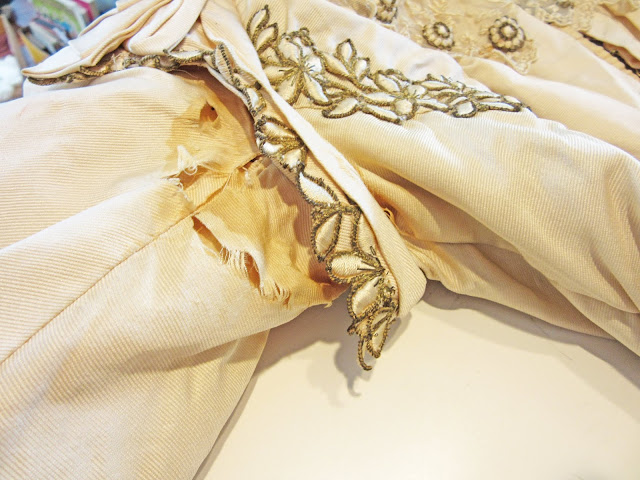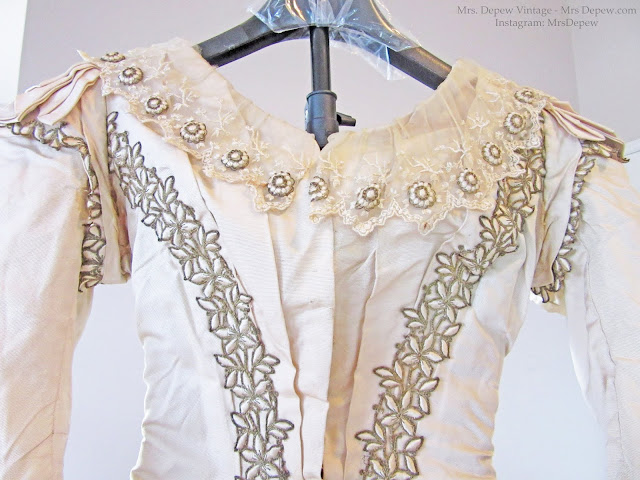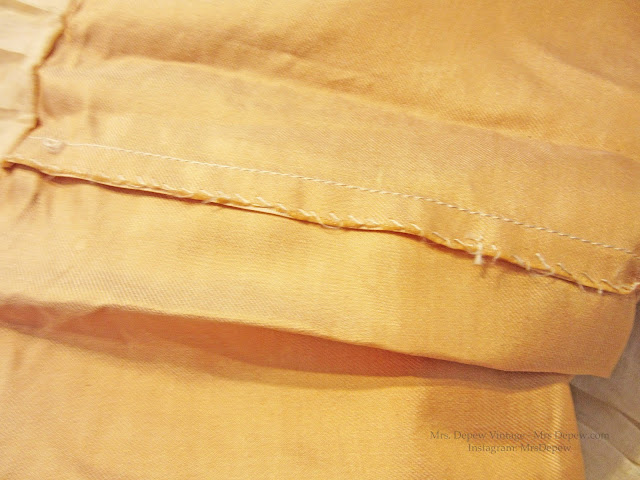Lately, I've been having fun reverse-engineering dresses into patterns. This is a technical, convoluted excuse for my "buying vintage clothing I'll never wear" habit. I just love to study original antique pieces, how they are constructed, what materials were used, which parts have held up to wear and use, and which parts haven't. Sometimes this manifests in a new pattern at Mrs. Depew Vintage, but most of the time, it just means hours spent becoming a (hopefully) smarter seamstress and designer.
Today, for your enjoyment, I present The Unexpected Victorian Dress. I was haunting a not-widely-used online auction site looking for patterns when I stumbled across a very blurry picture of a 1920s wedding dress covered in silk rosettes (more on that later). Just from the photo, I knew it to be adapted from the "robe de style" design; something I've been wanting to study in person for ages. The listing was vague, saying only "Dresses" and showing a much-abused 1920s dress hanging on a door. I bid furiously, knowing that if the plural turned out to be a typo and I only had this one dress to study, I'd be one happy girl. I won. A Giant box arrived weeks later at my door.
And inside was not one, not two, but three beautiful dresses for me to study.
The photos that follow are as detailed as I can get, and I have erred on the side of overkill, knowing that there are fashion historians out there that will be delighted with as much detail as possible.
With their help, I am still nailing down the dressmaker named, as well as trying to name its original, stunningly petite owner and perhaps date the dress which appears to be from the late 1880s to early 1890s.
Enjoy!
 |
| She was much too small for my dress form so I rigged up a stand using the hanger that came with it, my photo light umbrella stand, and another skirt hanger suspended from some old lingerie elastic loops attached to the hanger above. |
 |
| An unfortunate bit of rouge on one sleeve I'm afraid. |
 |
| A bit of a hole in sime of the back skirt lace overskirt. |
 |
| The skirt hem has layer after layer of pleated lace ruffles, followed by pinked silk trim, and over all of that sits a padded and ruched thick hem. |
 |
| It appears to have been put away without being cleaned and the hem has a few dirt-darkened sections. |
 |
| I like to imagine that the detached lace at the front skirt hem is from spirited dancing, and not from rough handling. |
 |
| There seems to be no end to the waist stays. Notice how the hooks and eyes alternate sides, so as to make the fit quite secure. |
 |
| A string tag inside reads "Adams" |
 |
| Notice how some of the seam edges around this stay have been scalloped before being bound? What a lovely detail for the interior of a gown! |
 |
| The right-side, The lace has gold metallic embroidery medallions. |
 |
| The underside of the embroidery. |
What follows is each layer of the hem from the outside in, showing each delicate layer in order as it is folded back from left to right.
 |
| There are two separate rows of pleated lace edging sewn to the flesh-colored underskirt edge. |
 |
| A stiff cotton underskirt. |
 |
| The hem at the train is quite heavy, about 1 inch thick, ruched and then stuffed with cotton wadding. |
 |
| Each underarm is the only place that the dress fabric has shattered. |
 |
| In a few places, the lace neckline ruffle has detached a bit from the bodice. |
 |
| The shoulders are copiously ornamented with a draped bow, then the embroidered trim over the slightly puffed shoulder. |
And that is the anatomy of an antique dress, my dears.
For more reading, you might enjoy looking at this somewhat later dress at the V&A.
Happy sewing!

























































What a treasure! :)
ReplyDeleteHow very beautiful! Thank you so much.
ReplyDeleteDrusilla Barron